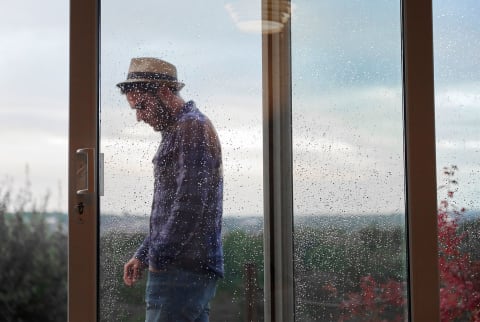Advertisement
4 Ways To Prevent Mold From Forming In Your Home After An Extreme Storm


Thanks to climate change, the world is set to experience more unprecedented weather events in the coming years. (And you don't need to look beyond Hurricane Ian to see that they are already causing major damage.) According to the IPCC's 2021 report, every region globally faces changes like intense rainfall, high levels of flooding, sea level rise, and more. In its working 2022 report, the Intergovernmental Panel on Climate Change states, "Approximately 3.3 to 3.6 billion people live in contexts that are highly vulnerable to climate change."
There's a lot to consider about how we as a species will weather climate change. However, there's one topic that rarely gets brought to the table when it comes to this worldwide crisis: indoor environmental health.
How our indoor spaces will be affected by global warming.
Our indoor environments play an enormous role in our ongoing well-being. The average person breathes 20,000 breaths per day and spends 90% of their time indoors1, so what's in these spaces matters.
If they are filled with microscopic particles such as microbial fragments, mold spores, bacteria, and mycotoxins, they will negatively affect our health. As the saying goes, "Just because you can't see something doesn't mean it isn't there." The longer someone is exposed to a toxic indoor space, the more foreign particles will enter their bodies through inhalation, absorption, and ingestion.
Extreme weather from climate change will only worsen the issue by bringing increased moisture into our homes. Water damage from flooding and storms generates the ideal environment for toxic particles to thrive. Mold, for example, can grow on a surface in as little as 24 hours if moisture and food sources are present. Once established in an indoor environment, they'll begin releasing microscopic particles into that space, lowering the air quality and contaminating the surfaces within.
As we fight to combat climate change, I'd argue that we also need to make sure our homes remain safe in the process.
What can we do about it?
Keeping our indoor environments safe from the worst effects of climate change will take a coordinated effort from the construction, remediation, and insurance industry. But there are some things we can do as individuals to protect ourselves and our spaces, too. Here's how I recommend getting started:
Stay on top of home maintenance.
Ensure your home is prepped and ready for extreme weather by staying on top of building maintenance. This involves keeping gutters clean and in good shape, regularly checking for structural issues and resolving any that pop up, and ensuring that landscape grading slopes down and away from the home in all directions.
Focus on air quality.
While the air quality shifts outdoors due to global warming, we must actively work to promote healthier air quality within our indoor environments. Investing in air purifiers, maintaining your HVAC system, deep cleaning often (especially dusting), and upgrading to the highest-rated MERV filters2 and changing them on time are all excellent ways to foster indoor air quality.
Consider your local conditions.
To prep your home for possible climate change events, you'll want to assess your local area and its risk factors. For example, as water levels rise worldwide, homes in low-lying areas will face increased flooding risk. Taking steps to mitigate water intrusions, such as installing flood shields and floor drain plugs, can help avoid opportunities for microbial growth. Each situation will be unique, so it's important to pay attention to how global warming might affect your specific location.
From there, action plans should be set in place should water damage occur. Microbial growth happens fast, so responding quickly and correctly is key to reducing contamination and exposure as much as possible. Plan ahead by knowing what steps you will take and which professionals you will call in the event of water damage.
Make sure you have the right insurance.
Speaking of damages, insurance coverage is a huge piece of the process of preparing a home for the effects of climate change. Crafting a comprehensive policy will help to avoid the high costs that can result from not being able to handle the situation adequately. Far too often, individuals are forced to deal with toxic spaces because they cannot afford to take the steps to eliminate the problem. A root cause of this issue is a lack of policy coverage.
When choosing insurance, ask questions such as:
- Is flooding and wind protection added?
- How much coverage is offered? Is it enough?
- Are there any specific exclusions prohibiting coverage?
Resolving a toxic environment can get expensive quickly. The more coverage a person has, the better protected they'll be for situations that pop up.
We're in this together.
Climate change will bring about an unknown number of obstacles, and we cannot forget to include the impact it will have on our indoor spaces. Solving this upcoming health crisis will take time and effort from all of us. The aforementioned actions are all ways to increase your personal awareness and safeguard your indoor environment right now. And who knows; they may help tremendously down the line.
Watch Next
Enjoy some of our favorite clips from classes
Enjoy some of our favorite clips from classes
What Is Meditation?
Mindfulness/Spirituality | Light Watkins
Box Breathing
Mindfulness/Spirituality | Gwen Dittmar
What Breathwork Can Address
Mindfulness/Spirituality | Gwen Dittmar
The 8 Limbs of Yoga - What is Asana?
Yoga | Caley Alyssa
Two Standing Postures to Open Up Tight Hips
Yoga | Caley Alyssa
How Plants Can Optimize Athletic Performance
Nutrition | Rich Roll
What to Eat Before a Workout
Nutrition | Rich Roll
How Ayurveda Helps Us Navigate Modern Life
Nutrition | Sahara Rose
Messages About Love & Relationships
Love & Relationships | Esther Perel
Love Languages
Love & Relationships | Esther Perel



















